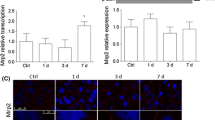Summary
The infusion of taurolithocholate (TLC) in vivo or in the isolated perfused liver of the rat causes cholestasis and cellular necrosis. In order to analyze the protective effect of bile salts differing in number and steric position of their hydroxy groups against TLC-induced cholestasis, isolated rat livers were perfused with taurocholate (TC), taurohyocholate (THC), tauroursocholate (TUC), taurodehydrocholate (TDHC), and tauroursodeoxycholate (TUDC) (16 and 32 μmol/l) with or without TLC (8 and 16 μmol/l). Bile flow, bile salt secretion, and the hydroxylation pattern of the bile salts secreted were analyzed.
TLC caused complete cholestasis after 15 min of perfusion. All bile salts studied had a protective effect. THC, TC, and TUDC completely abolished the cholestasis induced by TLC while TUC did so only for the first 10 min. TDHC was protective only as long as it was biotransformed into hydroxyoxo bile salts.
Coinfusion of bile salts did not influence uptake of TLC (≥93% of dose). Differences were found regarding the amount of TLC biotransformed (% of uptake): TC 50%; THC 32%; TUDC 36%; TUC 20%. Light microscopy revealed cellular necrosis, and dilated canaliculi were found in livers perfused with TLC only or in combination with TUC or TDHC, while the other bile salts prevented these changes.
We conclude that bile salts with low micelle-forming capacity have little protective effect against TLC-induced cholestasis. These bile salts induce less biotransformation of TLC than TC, THC, and TUDC. The protective effect is not dependent on the hydrocholeretic effect of the added bile salt and is not due to an uptake inhibition.
Similar content being viewed by others
References
Javitt NB, Emerman S (1968) Effect of sodium taurolithocholate on bile flow and bile acid excretion. J. Clin Invest 47:1002–1014
Miyai K, Mayr WW, Richardson AL (1975) Acute cholestasis induced by lithocholic acid in the rat. Lab Invest 31:527–535
Kakis G, Yousef IM (1978) Pathogenesis of lithocholate- and taurolithocholate-induced intrahepatic cholestasis in rats. Gastroenterology 75:595–607
Kakis G, Phillips MJ, Yousef IM, (1980) The respective roles of membrane cholesterol and of sodium potassium adenosine triphosphatase in the pathogenesis of lithocholate-induced cholestasis. Lab Invest 43:73–80
Schölmerich J, Becher M-S, Schmidt K, Schubert K, Kremer B, Feldhaus S, Gerok W (1984) Influence of hydroxylation and conjugation of bile salts on their membrane-damaging properties—studies on isolated hepatocytes and lipid membrane vesicles. Hepatology 4:661–666
Layden TI, Boyer IL (1977) Taurolithocholate induced cholestasis: taurocholate, but not dehydrocholate, reverses cholestasis and bile canalicular membrane injury. Gastroenterology 73:120–128
Miyai K, Richardson AL, Mayr W, Javitt NB (1977) Subcellular pathology of rat liver in cholestasis and choleresis induced by bile salts. Lab. Invest 36:249–258
Kakis G, Yousef IM (1980) Mechanism of cholic acid protection in lithocholate-induced intrahepatic cholestasis in rats. Gastroenterology 78:1402–1411
Bellentani S, Hardison WGM, Marchegiano P, Zanasi G, Manenti F (1987) Bile acid inhibition of taurocholate uptake by rat hepatocytes: role of OH groups. Am J Physiol 252:G339-G344
Baumgartner U, Hardison WGM, Miyai K (1987) Reduced cholestatic potency of taurolithocholate during backward perfusion of the rat liver. Lab Invest 56:576–582
Roda A, Hofmann AF, Mysels KJ (1983) The influence of bile salt structure on self-association in aqueous solutions. J Biol Chem 258:6362–6370
Schölmerich J, Kitamura S, Miyai K (1986) Structural and functional integrity of rat liver perfused in backward and forward directions. Res Exp Med 186:397–405
Schölmerich J, Kitamura S, Miyai K (1989) Effects of propylene glycol on redox state of the perfused rat liver—a note of caution. Res Exp Med 189:39–42
Schölmerich J, Kitamura S, Miyai KM (1983) Changes of the pattern of biliary bile acids during isolated rat liver perfusion. Biochem Biophys Res Commun 115:518–524
Roda A, Kricka LJ, DeLuca M, Hofmann AF (1982) bioluminescence measurement of primary bile acids using immobilized 7α-hydroxysteroid dehydrogenase application to serum bile acids. J Lipid Res 23:1354–1361
Schölmerich J, Berge Henegouwen GP von, Hofmann AF, DeLuca M (1984) A bioluminescence assay for total 3α-hydroxy bile acids in serum. Clin Chim Acta 137:21–32
Schölmerich J, Hinkley JE, MacDonald IA, Hofmann AF, DeLuca M (1983) A solid phase bioluminescence assay for 12α-hydroxy bile acids. Anal Biochem. 133:244–250
Schölmerich J, Roda A, DeLuca M (1986) Immobilized enzymes for assaying bile acids. Methods Enzymol 133:215–229
MacDonald IA, Sutherland JD (1983) Further studies on the bile salt induction of 7α- and 7β-hydroxysteroid dehydrogenase in clostridium absonum. Biochim Biophys Acta 750: 397–403
Anwer MS, Hegner D (1979) An enzymatic method for the quantitative determination of 3-keto bile acids. Anal Biochem 99:408–414
Baumgartner U, Miyai K, Hardison WG (1986) Greater taurodeoxycholate biotransformation during backward perfusion of rat liver. Am J Physiol 251:G431-G435
Rutishauser SCB, Stone SL (1975) Comparative effects of sodium taurodeoxycholate and sodium taurocholate on bile secretion in the rat, dog and rabbit, J Physiol 245:583–598
Anwer MS, Hegner D (1982) Importance of solvent drag and diffusion in bile acid-dependent bile formation: ion substitution studies in isolated perfused rat liver. Hepatology 2: 580–586
Anwer MS, Hegner D (1982) Sterospecific reduction of 3- and 7-oxo groups of oxocholanic acids in isolated perfused rat liver. Hoppe Seylers Z Physiol Chem 363:731–735
Schwenk M, Schwarz LR, Greim H (1977) Taurolithocholate inhibits taurocholate uptake by isolated hepatocytes at low concentrations. Naunyn Schmiedebergs Arch Pharmacol 298:175–179
Hayes JD, Strange RC, Percy-Robb W (1979) Identification of two lithocholic acid-binding proteins. Biochem J 181:699–708
Author information
Authors and Affiliations
Additional information
Supported by NIH grant no. AM 16/10 of the US Public Health Service (Dr. Miyai). J.S. was a recipient of a grant from the Thyssen Stiftung, FRG.
Rights and permissions
About this article
Cite this article
Schölmerich, J., Kitamura, S., Baumgartner, U. et al. Taurohyocholate, taurocholate, and tauroursodeoxycholate but not tauroursocholate and taurodehydrocholate counteract effects of taurolithocholate in rat liver. Res. Exp. Med. 190, 121–129 (1990). https://doi.org/10.1007/PL00020014
Received:
Accepted:
Issue Date:
DOI: https://doi.org/10.1007/PL00020014




